Even the briefest conversation with Mark Van Wagner quickly demonstrates two things: The first is his passionate interest in signs and semiotics. The second is the vastness and almost infinite interconnections of this field when submitted to close consideration by creative intellect.
Van Wagner is an artist, a curator and—since March 2017 with his wife Tonja Pulfer—the owner of Marquee Projects gallery in Bellport, NY. Even the name of the gallery gives away something about his interest in signs and what they mean or represent. Further evidence, if any were needed, has been on view since October 28, 2017 in the four separate installments comprising the “It’s a Sign” exhibition at the gallery. The final show of the series, Exhibition IV, curated by Maya Schindler, opened on January 20 and closes on February 11, 2018.
.
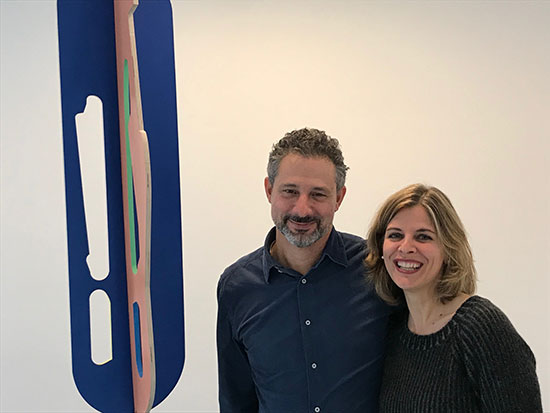
Owners Van Wagner and Tonja Pulfer. Photo: A. Botsford.
.
In a recent interview at the gallery, Van Wagner said he first had the concept for an “It’s a Sign” exhibition tackling signs and semiotics—the philosophical study of signs, symbols and meaning-making—some two years ago. “Signs have always interested me,” he said, and so he broached the idea with a fellow curator, Enrico Gomez, and the two of them started to formulate an approach.
.
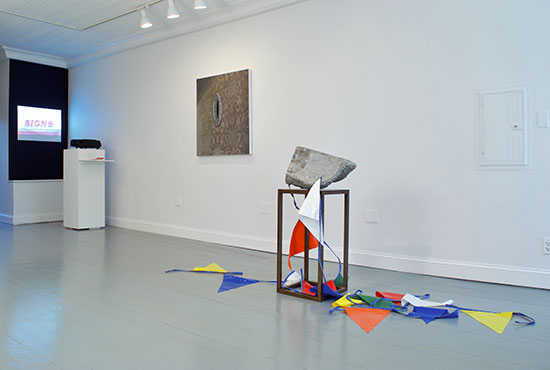
"It's a Sign: Exhibition I" at Marquee Projects. Courtesy of Marquee Projects.
.
Van Wagner pitched the idea to a few galleries and curators but didn’t generate any interest. Then, when he and his wife took over the gallery space at 14 Bellport Lane, he thought, “why not do it as three, four or five shows?” He and Gomez had already agreed that it was a “big idea” and there were many different ways to go with it, with Gomez envisioning one kind of curation and Van Wagner another. So presenting one “It’s a Sign” exhibition as four separate shows seemed to make sense, Van Wagner said, because then “everyone can do it their own way.”
The four shows in the small space would each have their own curator. Beyond addressing the common “big idea” of signs and semiotics, the exhibitions would be linked by an “exquisite corpse” continuity—described by Van Wagner as a sort of “call and response” dialogue—with each show after the first making use of an artwork from the previous exhibition.
Van Wagner curated Exhibition I of “It’s a Sign,” working, in his words, to “address the diversity of interpretation.” The artists he selected—Jeff Feld, Enrico Gomez, Mikael Levin, and Emily Quinn—had what he called “a whole bag of tricks in the artwork they had done over the years,” and he, as curator, got to select pieces that addressed or investigated the theme.
.
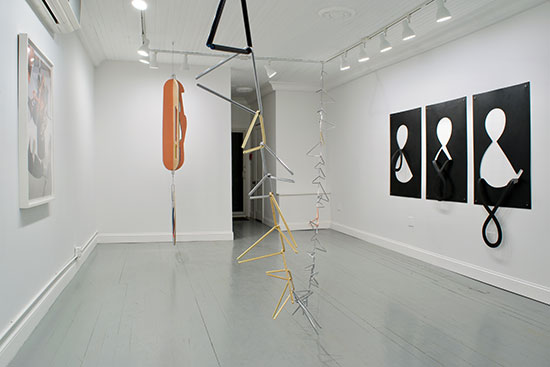
"It's a Sign: Exhibition IV" at Marquee Projects. Courtesy of Marquee Projects.
.
Robert Zungu was the curator for Exhibition II, which featured works by a single artist, Andrew Laumann, along with a print of a single photograph taken from an installation by Mikael Levin in the first show. Exhibition III was curated by Enrico Gomez and included works by artists Bert Benally, Nick DePirro, and Paul Loughney along with a painting from Exhibition I by Emily Quinn.
Maya Schindler, the curator for the current show, Exhibition IV, carried over a painting by Paul Loughney from Exhibition III and presented works by Alison O’Daniel and Sreshta Rit Premnath.
Van Wagner said that one of the reasons for requiring that an artist or artwork be carried over to the next exhibition was aligned with his motivation for taking on the theme of semiotics for a series. “It’s a sign of the times,” he said, unable to get away from the exhibitions’ frame of reference, “that there is so much separation right now. We have to communicate; we have to have discourse to understand what is happening in the world now.”
Perhaps most effective in the creation of dialogue and discourse were the choices each curator made for a single artwork to put in the front window of the gallery facing the street. The pieces were part of each exhibition but also served, by their marquee placement facing outward, as signs themselves, and invitations to viewers to come inside.
For Exhibition I, Van Wagner chose a large stencil by Jeff Feld that reads “WE BUY GOLD.” Robert Zungu installed in the front window a piece by Andrew Lauman recreating the cover headline of a pamphlet he had been handed repeatedly at a train station: “If There Is A God, Why Doesn’t He Prove It?”
.
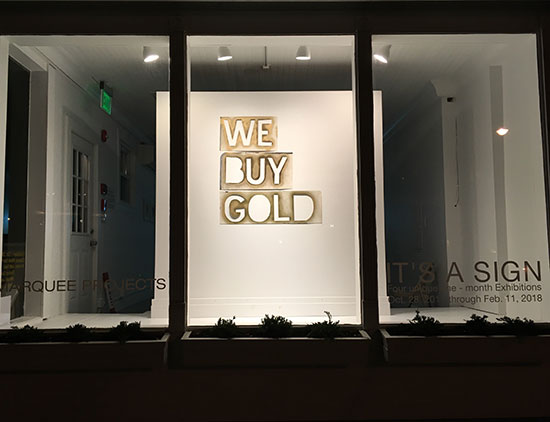
"WE BUY GOLD" by Jeff Feld. “It’s a Sign: Exhibition I.” Courtesy of Marquee Projects.
.
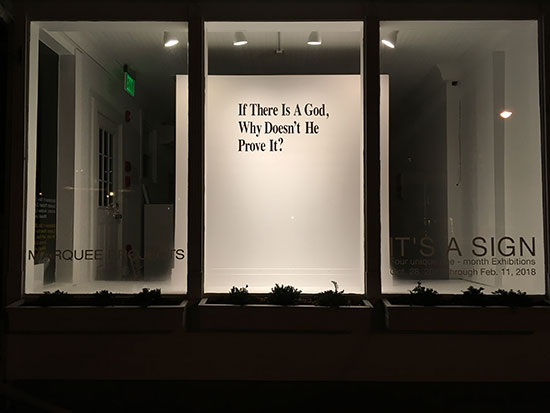
Artwork by Andrew Lauman. “It’s a Sign: Exhibition II.” Courtesy of Marquee Projects.
.
Instead of words, the front window for Exhibition III featured a painting by Emily Quinn of a window with curtains in the center, with the left and right sides of the gallery storefront masked off.
.
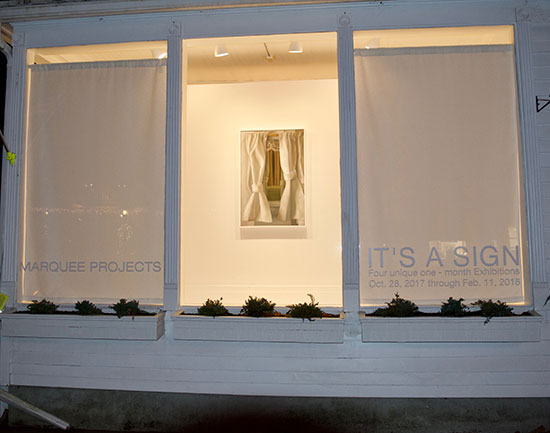
"Looking In/Looking Out" by Emily Quinn. “It’s a Sign: Exhibition III.” Courtesy of Marquee Projects.
.
Moving into an overt suggestion of politics for the front window for Exhibition IV, curator Maya Schindler selected a work by Sreshta Rit Premnath titled “Signs for Wonders,” four veloxed photographs of a man giving the thumbs-down sign. The composition is framed to focus on the gesture, showing only the hand and a little bit of a suit and tie; viewers are left to speculate on the man’s identity.
.

“Signs for Wonders” by Sreshta Rit Premnath. “It’s a Sign: Exhibition IV.” Courtesy of Marquee Projects.
.
On close inspection or a second look, it becomes apparent that the photos have been inverted or hung upside down: the original gesture was a thumbs-up. Viewers and passersby are left to speculate on the meaning of a politician’s thumbs-up presented as a thumbs-down.
With women coming into the gallery to see if they could sell their jewelry and then perusing the exhibition, and lay people as well as a minister coming in to discuss the notion of God proving his existence as well as the meaning of signs as art, both Van Wagner and Pulfer said that the “It’s a Sign” exhibition series was “an outstanding way” to end their first season.
“Part of the intention,” Van Wagner said, “was to attract many different people who don’t usually look at art. It was a huge theme and everyone did it differently so that everyone could get more out of it.”
“People wanting to interact shows a kind of caring and support,” Pulfer said with a smile. “It makes a community.”
_______________________
BASIC FACTS: “It’s a Sign: Exhibition IV,” curated by Maya Schindler, is on view January 20 to February 11, 2018 at Marquee Projects, 14 Bellport Lane, Bellport, NY 11713. www.marqueeprojects.org
________________________
Copyright 2018 Hamptons Art Hub LLC. All rights reserved.
